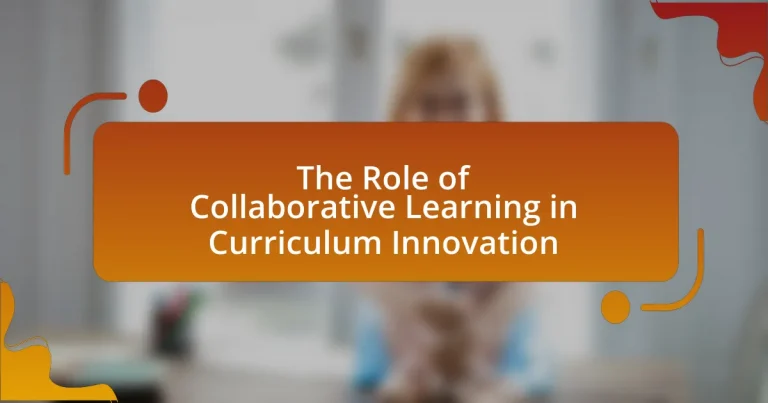Collaborative learning is a pivotal element in curriculum innovation, enhancing student engagement and critical thinking through teamwork and shared problem-solving. This article explores the influence of collaborative learning on curriculum design, highlighting its key principles, benefits, and the differences from traditional learning methods. It also addresses the challenges educators face in implementing collaborative strategies, the role of technology in facilitating collaboration, and best practices for integrating collaborative learning into curricula. Successful examples of collaborative learning initiatives are presented, demonstrating their effectiveness in improving academic outcomes and fostering essential skills for the 21st century.

What is the Role of Collaborative Learning in Curriculum Innovation?
Collaborative learning plays a crucial role in curriculum innovation by fostering active engagement and enhancing critical thinking among students. This approach encourages learners to work together, share diverse perspectives, and solve problems collectively, which leads to deeper understanding and retention of knowledge. Research indicates that collaborative learning environments can improve academic performance; for instance, a study published in the “Journal of Educational Psychology” found that students in collaborative settings scored higher on assessments compared to those in traditional learning environments. This evidence supports the notion that integrating collaborative learning into curricula not only promotes innovation but also equips students with essential skills for the 21st century, such as teamwork and communication.
How does collaborative learning influence curriculum design?
Collaborative learning significantly influences curriculum design by promoting active engagement and fostering critical thinking among students. This approach encourages educators to create curricula that emphasize teamwork, communication, and problem-solving skills, aligning with modern educational goals. Research indicates that collaborative learning environments lead to improved academic outcomes, as evidenced by a study published in the “Journal of Educational Psychology,” which found that students in collaborative settings demonstrated higher retention rates and deeper understanding of material compared to traditional learning methods. Consequently, curriculum designers are increasingly integrating collaborative projects and peer-to-peer learning opportunities to enhance student learning experiences and outcomes.
What are the key principles of collaborative learning?
The key principles of collaborative learning include shared responsibility, active participation, and mutual respect among learners. Shared responsibility ensures that all group members contribute to the learning process, fostering a sense of ownership and accountability. Active participation encourages learners to engage with each other, facilitating deeper understanding through discussion and interaction. Mutual respect creates a supportive environment where diverse perspectives are valued, enhancing the collaborative experience. Research by Johnson and Johnson (1999) highlights that these principles lead to improved academic achievement and social skills, validating their importance in effective collaborative learning environments.
How does collaborative learning differ from traditional learning methods?
Collaborative learning differs from traditional learning methods primarily in its emphasis on group interaction and shared knowledge construction. In collaborative learning, students actively engage with one another, working together to solve problems and complete tasks, which fosters critical thinking and communication skills. In contrast, traditional learning often relies on a teacher-centered approach where information is delivered through lectures, and students are passive recipients of knowledge. Research indicates that collaborative learning can enhance student engagement and improve academic outcomes, as evidenced by a study published in the “Journal of Educational Psychology,” which found that students in collaborative settings demonstrated higher retention rates and deeper understanding of material compared to those in traditional classrooms.
Why is collaborative learning important for curriculum innovation?
Collaborative learning is important for curriculum innovation because it fosters diverse perspectives and enhances problem-solving skills among students. By engaging in collaborative activities, learners share knowledge and experiences, which leads to the co-creation of ideas and solutions that can improve curriculum design. Research indicates that collaborative learning environments promote critical thinking and creativity, essential components for innovative curricula. For instance, a study by Johnson and Johnson (2014) found that students in collaborative settings performed better academically and developed higher-order thinking skills compared to those in traditional learning environments. This evidence supports the notion that collaborative learning is a key driver of curriculum innovation.
What are the benefits of integrating collaborative learning into the curriculum?
Integrating collaborative learning into the curriculum enhances student engagement and improves academic performance. Research indicates that collaborative learning fosters critical thinking and problem-solving skills, as students work together to tackle complex tasks. A study by Johnson and Johnson (2014) found that students involved in collaborative learning environments demonstrated higher achievement levels compared to those in traditional settings. Additionally, collaborative learning promotes social skills and teamwork, preparing students for real-world interactions and professional environments. This approach also encourages diverse perspectives, enriching the learning experience and fostering a deeper understanding of the subject matter.
How does collaborative learning enhance student engagement and motivation?
Collaborative learning enhances student engagement and motivation by fostering a sense of community and shared responsibility among learners. When students work together, they actively participate in discussions, share diverse perspectives, and support each other’s learning, which increases their investment in the educational process. Research indicates that collaborative learning environments lead to higher levels of intrinsic motivation, as students feel more connected to their peers and are more likely to take ownership of their learning. For example, a study by Johnson and Johnson (2009) found that students in collaborative settings demonstrated greater motivation and achievement compared to those in traditional, competitive environments. This evidence supports the assertion that collaborative learning significantly boosts both engagement and motivation among students.

What are the challenges of implementing collaborative learning in curriculum innovation?
Implementing collaborative learning in curriculum innovation faces several challenges, including resistance from educators, logistical issues, and assessment difficulties. Educators may resist collaborative approaches due to a lack of training or belief in traditional teaching methods, which can hinder the adoption of innovative practices. Logistical issues arise from the need for adequate resources, such as technology and space conducive to group work, which may not be readily available in all educational settings. Additionally, assessing collaborative learning outcomes can be complex, as traditional assessment methods may not effectively measure individual contributions and group dynamics. These challenges highlight the need for targeted professional development, resource allocation, and the development of new assessment strategies to facilitate successful implementation.
What obstacles do educators face when adopting collaborative learning?
Educators face several obstacles when adopting collaborative learning, including resistance to change, lack of training, and insufficient resources. Resistance to change often stems from traditional teaching practices that prioritize individual learning over group work, making it difficult for educators to shift their mindset. Additionally, many educators report feeling unprepared to implement collaborative strategies due to a lack of professional development and training focused on these methods. Furthermore, inadequate resources, such as limited access to technology or materials that facilitate group work, can hinder the effective implementation of collaborative learning. These challenges are supported by research indicating that successful adoption of collaborative learning requires not only a shift in pedagogical approach but also institutional support and adequate training for educators.
How can resistance to change impact the implementation of collaborative learning?
Resistance to change can significantly hinder the implementation of collaborative learning by creating barriers to acceptance and engagement among educators and students. When individuals are resistant, they may refuse to adopt new teaching methods or collaborative practices, leading to a lack of participation and enthusiasm in group activities. Research indicates that resistance often stems from fear of the unknown, perceived threats to established routines, or skepticism about the effectiveness of collaborative approaches. For instance, a study by Kahn and O’Rourke (2018) found that educators who were hesitant to embrace collaborative learning reported lower student engagement and achievement, demonstrating that resistance directly correlates with the success of such initiatives. Therefore, addressing resistance is crucial for fostering an environment conducive to collaborative learning.
What strategies can be employed to overcome these challenges?
To overcome challenges in collaborative learning for curriculum innovation, educators can implement structured group activities that promote clear communication and shared goals. These activities can include peer teaching, where students explain concepts to each other, fostering understanding and collaboration. Research indicates that structured collaborative tasks enhance student engagement and improve learning outcomes, as evidenced by a study published in the Journal of Educational Psychology, which found that students participating in peer teaching scored significantly higher on assessments compared to those who learned independently. Additionally, providing professional development for educators on facilitating collaborative learning can equip them with effective strategies to manage group dynamics and address potential conflicts, further enhancing the collaborative learning experience.
How does technology facilitate collaborative learning in curriculum innovation?
Technology facilitates collaborative learning in curriculum innovation by providing tools that enhance communication, resource sharing, and interactive engagement among learners. For instance, platforms like Google Classroom and Microsoft Teams enable real-time collaboration on projects, allowing students to work together regardless of their physical location. Research indicates that the use of technology in collaborative learning environments can lead to improved student engagement and academic performance, as evidenced by a study published in the Journal of Educational Technology & Society, which found that technology-mediated collaboration significantly enhances learning outcomes.
What tools and platforms support collaborative learning initiatives?
Tools and platforms that support collaborative learning initiatives include Google Workspace, Microsoft Teams, Slack, and Zoom. Google Workspace enables real-time document collaboration and communication, while Microsoft Teams integrates chat, video conferencing, and file sharing for seamless teamwork. Slack offers channels for organized discussions and integrations with various apps, enhancing collaboration. Zoom provides video conferencing capabilities that facilitate group discussions and remote learning. These tools are widely adopted in educational settings, demonstrating their effectiveness in fostering collaborative learning environments.
How can technology enhance communication and collaboration among students?
Technology enhances communication and collaboration among students by providing tools that facilitate real-time interaction and shared resources. Platforms such as Google Workspace and Microsoft Teams enable students to collaborate on projects simultaneously, regardless of their physical location. Research indicates that 70% of students feel more engaged in collaborative tasks when using digital tools, as these platforms allow for instant feedback and diverse input, fostering a more inclusive learning environment. Additionally, video conferencing tools like Zoom and educational apps like Padlet promote active participation and idea sharing, further strengthening peer relationships and collective problem-solving skills.

What are the best practices for integrating collaborative learning into curriculum innovation?
The best practices for integrating collaborative learning into curriculum innovation include fostering a culture of teamwork, designing interdisciplinary projects, and utilizing technology to facilitate communication. Fostering a culture of teamwork encourages students to engage with one another, enhancing their social skills and collective problem-solving abilities. Designing interdisciplinary projects allows students to apply knowledge from various subjects, promoting deeper understanding and collaboration. Utilizing technology, such as collaborative platforms and tools, supports real-time communication and resource sharing, making collaborative learning more effective. Research by Johnson and Johnson (2014) highlights that structured collaborative learning environments significantly improve student engagement and academic achievement, validating these practices.
How can educators effectively design collaborative learning experiences?
Educators can effectively design collaborative learning experiences by incorporating structured group activities that promote interaction and shared responsibility among students. Research indicates that well-defined roles within groups enhance accountability and engagement, leading to improved learning outcomes. For instance, a study by Johnson and Johnson (2014) highlights that cooperative learning strategies, such as peer teaching and group problem-solving, significantly increase student achievement and retention of knowledge. By integrating these strategies into the curriculum, educators can foster an environment where collaboration is not only encouraged but also essential for academic success.
What role does assessment play in collaborative learning environments?
Assessment plays a critical role in collaborative learning environments by providing feedback that enhances group dynamics and individual understanding. It facilitates the identification of strengths and weaknesses within the group, allowing members to adjust their contributions and strategies accordingly. Research indicates that formative assessments, such as peer evaluations and self-assessments, promote accountability and encourage active participation among learners. For instance, a study by Garrison and Vaughan (2008) highlights that effective assessment practices in collaborative settings lead to improved learning outcomes and foster a sense of community among participants.
How can feedback be utilized to improve collaborative learning outcomes?
Feedback can be utilized to improve collaborative learning outcomes by providing specific, actionable insights that guide group members in enhancing their contributions and interactions. When feedback is timely and constructive, it fosters a culture of open communication, allowing participants to reflect on their performance and adjust their strategies accordingly. Research indicates that structured feedback mechanisms, such as peer assessments and instructor evaluations, can significantly enhance group dynamics and individual accountability, leading to improved learning outcomes. For instance, a study published in the Journal of Educational Psychology found that students who received regular feedback on their collaborative efforts demonstrated higher engagement and better academic performance compared to those who did not receive feedback.
What are some successful examples of collaborative learning in curriculum innovation?
Successful examples of collaborative learning in curriculum innovation include the Project-Based Learning (PBL) approach implemented in various educational institutions, such as High Tech High in California. This model emphasizes teamwork and real-world problem-solving, allowing students to engage in projects that require collaboration across disciplines. Research by Thomas Markham in “Project Based Learning Handbook” highlights that students in PBL environments demonstrate higher engagement and retention of knowledge compared to traditional learning methods. Another example is the use of Collaborative Online International Learning (COIL) programs, where students from different countries work together on shared projects, fostering cross-cultural collaboration and enhancing global competencies. A study published in the “Journal of Studies in International Education” by O’Dowd and Lewis shows that COIL participants report improved communication skills and cultural awareness. These examples illustrate the effectiveness of collaborative learning in driving curriculum innovation and enhancing educational outcomes.
How have schools successfully implemented collaborative learning strategies?
Schools have successfully implemented collaborative learning strategies by integrating group projects, peer teaching, and technology-enhanced collaboration into their curricula. For instance, many schools utilize project-based learning, where students work in teams to solve real-world problems, fostering critical thinking and teamwork skills. Research from the University of California, Los Angeles, indicates that students engaged in collaborative learning environments show improved academic performance and higher retention rates. Additionally, the use of digital platforms, such as Google Classroom, allows for seamless collaboration among students, enabling them to share resources and communicate effectively. These strategies not only enhance student engagement but also prepare learners for collaborative work in their future careers.
What lessons can be learned from these successful implementations?
Successful implementations of collaborative learning in curriculum innovation demonstrate that fostering teamwork enhances student engagement and improves learning outcomes. Evidence from various educational studies indicates that collaborative learning environments lead to higher retention rates and deeper understanding of material. For instance, a meta-analysis by Johnson and Johnson (2014) found that cooperative learning strategies significantly increase academic achievement across diverse student populations. Additionally, these implementations highlight the importance of structured group dynamics, where clear roles and responsibilities contribute to effective collaboration. This structured approach not only promotes accountability but also encourages diverse perspectives, enriching the learning experience.
What practical tips can educators use to foster collaborative learning?
Educators can foster collaborative learning by implementing structured group activities that promote teamwork and communication. For instance, using project-based learning allows students to work together on real-world problems, enhancing their collaborative skills. Research indicates that students engaged in collaborative learning environments show improved critical thinking and problem-solving abilities, as highlighted in a study by Johnson and Johnson (1999) which found that cooperative learning leads to higher achievement and greater retention of knowledge. Additionally, incorporating technology tools, such as collaborative platforms like Google Workspace, can facilitate communication and resource sharing among students, further supporting collaborative efforts.


